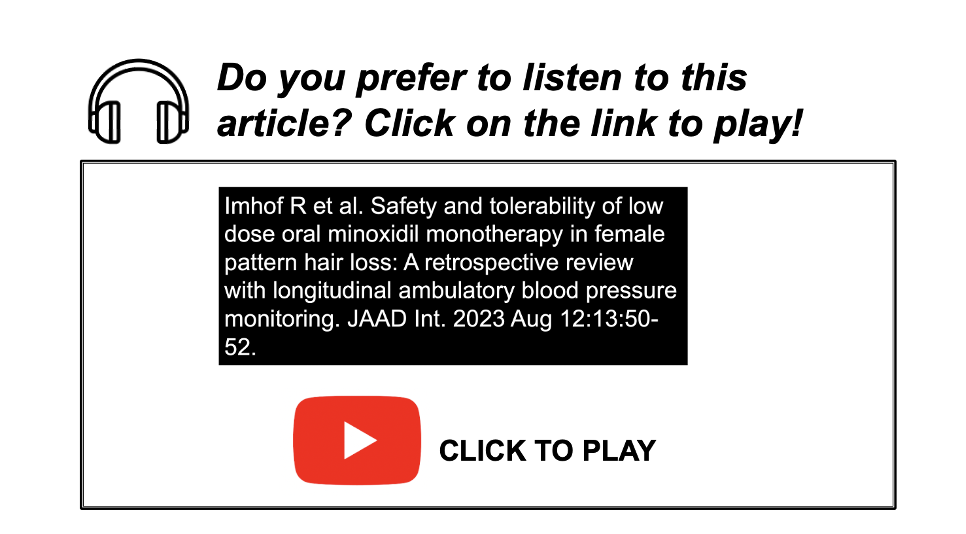Low Dose Oral Minoxidil in Women: Minimal Changes in Blood Pressure
Oral Minoxidil Use in Women: No Major Changes in Blood Pressure
A number studies in the past few years have examined the benefits and side effects of low dose oral minoxidil in women with androgenetic alopecia.
In 2020, we reviewed a nice study by Ramos and colleagues which taught us that 5 % minoxidil was pretty similar in effectiveness to 1 mg LDOM. Side effects were higher with LDOM including a higher chances of hypertrichosis, swelling in the feet and an overall increased heart rate by about 6 beats per minute.
Imhof R et al. 2023
A new study set out to evaluate the effects of LDOM in female patients with FPHL.
The authors performed a retrospective review of adult female patients at Mayo clinic treated with LDOM for FPHL over a five year period.
There were 25 patients in their study. The mean age of 61 years (range: 28-77 years). The most common LDOM strength was 1.25 mg daily (13, 52%) but 40 % (10 patients) were treated with 2.5 mg daily. 8 % of patients were treated with 0.625 mg daily.
The mean duration of the treatment was fairly short at 6.2 months (range: 4-11 months).
Disease improvement and hair regrowth was noted in 9 patients (36%) who were being treated with LDOM, while unaltered disease progression was noted in 3 patients (12%). We are not told which subset of patients these were or the dose they were used.
Five patients (20%) reported adverse side effects due to the LDOM treatment, including facial hypertrichosis (4, 16%) and fluid retention/lower limb edema (1, 4%). .
There was a mean decrease in systolic blood pressure of 2.8 mmHg, in diastolic blood pressure DBP of 1.4 mmHg, and an increase in heart rate HR of 4.4 beats/min.
Conclusion
I liked this study. It’s small so it’s hard to know what to make of the data.
It’s a short study so we don’t really know all the benefits of LDOM. But about 40 % have some benefits. This is not that dissimilar to topical minoxidil but this was not a comparative trial so we can’t really comment much on this point. We can’t forget that for many patients LDOM isn’t necessarily better - it’s just different. Of course for some patient’s it is better! In fact, when we review the recent Gupta network meta-analysis we can see that topical minoxidil twice daily probably even beats out oral minoxidil at 1 mg. (see Link to Study)
What I liked about this trial is the proportion of patients in older age groups that were included. I rarely use LDOM in patients above 70 so I was pretty intrigued to see that the mean age was 61 and there were patients 77 years of age in this study.
I don’t find that patients of older age groups in my clinic tolerate oral minoxidil super well and I rarely if ever prescribe in those over 70 years. I’m not sure I have any data which is convincing me to change my mind quite yet but I’m on the watch.
I’m not a great fan of using LDOM 2.5 mg doses. I probably have less than 10 patients in my practice on 2.5 mg and hundreds and hundreds on 1.25 mg, 0.625 mg, 1.875 mg.
I’m always keen to see how patients on 2.5 mg do. Some of my patients of course do really well (and that’s why they are on 2.5 mg). But a lot of patients get fluid retention and hypertrichosis that is just not acceptable to them.
This is a short study. The mean duration fo treatment was 6 months and some were just treated for 4 months. It’s hard to know after 4 months if all the side effects that were going to occur are going to occur – especially if a patient recently bumped up their dose. It takes 6-9 months (and sometimes even longer) to see all the benefits of LDOM so this study may have underestimated side effects and underestimated benefits and underestimated the drop out rate.
I’m not so excited to see that heart rate increases with oral minoxidil. I think this needs more study. Yes, it’s small but this is not so great. We need more data to understand this and to understand the range of heart rate effects.
Nevertheless, this is a valuable study to our growing list of LDOM studies.
REFERENCE
Imhof R et al. Safety and tolerability of low dose oral minoxidil monotherapy in female pattern hair loss: A retrospective review with longitudinal ambulatory blood pressure monitoring. JAAD Int. 2023 Aug 12:13:50-52.
Ramos PM, Sinclair RD, Kasprzak M, Miot HA. Minoxidil 1 mg oral versus minoxidil 5% topical solution for the treatment of female-pattern hair loss: A randomized clinical trial. J Am Acad Dermatol. 2020;82(1):252-253.
Gupta AK et al. The relative effect of monotherapy with 5-alpha reductase inhibitors and minoxidil for female pattern hair loss: A network meta-analysis study. J Cosmet Dermatol. 2023 Jun 29
This article was written by Dr. Jeff Donovan, a Canadian and US board certified dermatologist specializing exclusively in hair loss.





